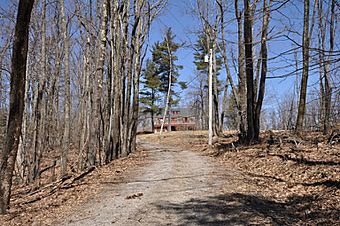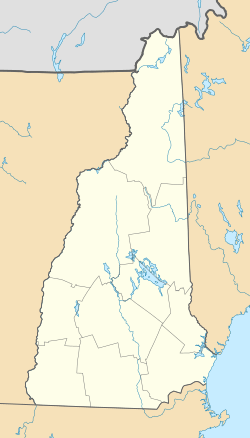Stonehenge (Dublin, New Hampshire) facts for kids
Quick facts for kids |
|
|
Stonehenge
|
|
 |
|
| Location | Windmill Hill Rd., Dublin, New Hampshire |
|---|---|
| Area | 0.6 acres (0.24 ha) |
| Built | 1889 |
| Architectural style | Shingle Style |
| MPS | Dublin MRA |
| NRHP reference No. | 83004079 |
| Added to NRHP | December 18, 1983 |
Stonehenge is a special old house in Dublin, New Hampshire. It's also known as Stone Cottage or High House. This house was built way back in 1889. It was one of the very first summer homes in that part of Dublin.
Stonehenge was a really important part of the land owned by the Parsons family. Today, it is listed on the National Register of Historic Places. This means it's a historic building worth protecting!
What is Stonehenge Like?
Stonehenge is a large, interesting house. It has 2 and a half stories. The house is built in a style called Shingle Style. This means its upper parts are covered in wooden shingles, like big tiles.
The lower part of the house is made from big, rough stones. It also has huge chimneys made of fieldstone. You can see special "eyebrow dormers" on the back roof. These are small windows that look like eyebrows!
A Look at Its History
This unique house was built in 1889. A person named F. W. Stevens built it for Martha Parsons. Martha's father was a rich merchant from Boston. Stonehenge was the first of many summer homes the Parsons family built in the area.
Famous Visitors
In 1913, a very important person rented Stonehenge. This was Cecil Spring Rice. He was the British Ambassador to the United States. An ambassador is like a country's main representative in another country. He rented Stonehenge as part of a "summer embassy." This means it was a place where British officials could work during the warmer months.
New Owners and Changes
Martha Parsons passed away in 1934. After that, the house was sold to a composer named Timothy Spelman. A composer is someone who writes music. He even had a studio right there in the house!
In 1950, Frank McKenna bought the property. He made a big change to the house. He took one part, or "wing," of the house off. Then, he moved it down the hill to the road. That part of the house is now known as the McKenna Cottage.



